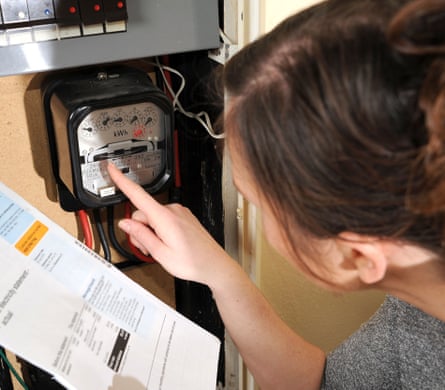
It has already been described as the year of the squeeze, and whichever way you look at it, 2022 looks set to go down as the year that most of us became worse off. Increases in rail fares, phone bills, national insurance and mortgage repayments have all been announced, and energy bills could rocket if wholesale gas prices remain high and the government resists pressure to act. It will be a particular disaster for those on fixed incomes and benefits but even those on generous incomes are going to feel the heat. The next four months are crucial. Here’s what is heading your way.
Gas and electricity bills
If you think your domestic energy bills have gone up a lot in recent months, you had better prepare yourself for a shock. Bills could rise by another 50%, to as much as £2,000 a year on 1 April, for an average household paying by direct debit.
Those in bigger properties, or working at home, people who live in the coldest parts of the country, and those who need to keep warm for medical reasons, could pay much more.
A spate of energy supplier collapses and high wholesale gas prices have left the majority of UK homes paying gas and electricity tariffs capped by the regulator, Ofgem.
 View image in fullscreenOfgem reviews the energy price cap every six months. Photograph: Simon Dack/Alamy
View image in fullscreenOfgem reviews the energy price cap every six months. Photograph: Simon Dack/Alamy
Ofgem reviews the cap – the maximum amount it will allow suppliers to charge for each unit of gas and electricity – every six months. In early February, it will announce the new rates to be applied to bills from 1 April. All the indications are that prices will rise and the current cap equal to £1,277 a year for average use will rise to something closer to £2,000.
That will mean savvy customers, who were on the best deals and paying as little as £1,000 a year last autumn, will have seen their energy bill double in a little over six months.
High energy prices are going to make the biggest impact on most households’ disposable incomes this year – not least as they start to feed into the cost of other items. Businesses are facing even steeper increases and are not protected by the cap.
This week, Boris Johnson appeared to rule out a temporary VAT removal. Currently, VAT is charged at 5% on energy bills and accounts for £65 per average bill, which would be closer to £100 after the cap is increased as expected. Winter fuel payments, paid to those born on or before 26 September 1955 and on some benefits, could be increased. These are currently worth between £100 and £300. The warm homes discount is worth £140 to those on certain benefits but is not available to customers of smaller suppliers.
Food bills
Households are already having to make their food budget go further, with the price of staples such as beef mince and crisps, as well as toiletries, rising fastest. Fresh increases are also in prospect as City analysts say struggling firms are eager to pass on higher costs now Christmas is over.
Annual food price inflation reached 3.5% in December, adding almost £15 to the average monthly grocery bill, according to the data firm Kantar. Fraser McKevitt, its head of retail and consumer insight, said food prices rose sharply in the spring of 2020 when promotions were cut to maintain product availability but before that you would have to go back almost four years to January 2018 to see inflation running higher.
 View image in fullscreenThe price of crisps is rising fast. Photograph: Hera Food/Alamy
View image in fullscreenThe price of crisps is rising fast. Photograph: Hera Food/Alamy
Prescription charges
Millions of people in England could face a double blow on 1 April as rising charges may go hand in hand with the over-60s being made to pay for the first time.
In July last year, ministers proposed raising the qualifying age for free prescriptions in England from 60 to 66, thereby aligning the age for NHS prescription charge exemptions with the state pension age. No starting date has been announced but some have suggested it might come into effect in April.
Campaigners say the move would result in 2.4 million more people paying prescription charges, with the average person in their early 60s paying £50 to £100 a year unless they qualify for another exemption.
Prescription charges have risen every 1 April in recent years and currently stand at £9.35. The expectation is that they will rise again, probably by at least 20p.
Rail fares
Normally a 3.8% increase in rail fares would lead to a huge outcry but this year the percentage increase looks relatively modest in comparison to some other price increases faced by consumers.
The 1 March increase officially applies to regulated fares – such as season tickets, long-distance returns and anytime urban fares – in England alone but is likely to be reflected throughout UK rail.
An annual five-day season ticket from Guildford in Surrey to London terminals currently costs £3,936, or £4,868 with tube travel thrown in. Anyone going back to the office full-time after March will pay £150 more, or £185 if they use the underground, too. A peak-time single from Bristol to Bath will rise by 33p to £9.
 View image in fullscreenThe 1 March increase officially applies to regulated fares in England but is likely to be reflected throughout UK rail. Photograph: Steve Parsons/PA
View image in fullscreenThe 1 March increase officially applies to regulated fares in England but is likely to be reflected throughout UK rail. Photograph: Steve Parsons/PA
Phone and broadband
This week, Virgin Media announced its customers will be paying an average of £56 a year more for their TV and broadband packages from March. The company has not published what the percentage increase is for TV and broadband bills but did admit its Virgin Mobile customers are facing increases of close to 10% on their airtime charges from April.
What Virgin does is usually followed by companies such as Sky, TalkTalk and BT. BT customers who signed up or recontracted with BT after September 2020 can look forward to an annual price increase in line with inflation (January’s CPI figure) plus an additional 3.9%, which could turn out to be a rise of close to 10%.
Last year, Sky increased its bills by an average of £36 a year up to a cap of £72. In the past, these firms have raised their tariffs on 1 April, now dubbed the UK’s price increase day.
Don’t forget the return of roaming charges for those visiting Europe this year
Tesco Mobile pay-monthly customers face a series of price increases from 9 February. Sending a picture message will go from 25p to 55p and calling countries such as Australia, South Africa and the US will go from 25p a minute to £1 a minute. Customers who use more than their monthly allowance will be charged 55p a minute (up from 25p), while listening to voicemails goes from 15p a minute to 55p and texts from 10p to 20p each.
Don’t forget the return of roaming charges for those visiting Europe this year, courtesy of Brexit. A family of four all taking their phones to Spain for a week will pay £56.
Mortgages and council tax
Borrowers who are on their lender’s standard variable rate (SVR) will see their monthly payments go up after the Bank of England’s decision to increase the base rate in December.
Although not tied to the base rate, SVRs tend to move up in line with it, and this time is no exception – most of the UK’s biggest lenders have announced that from 1 February they will increase borrowing costs by 0.15 percentage points. For a borrower with a mortgage of £150,000 arranged over 20 years, this will add just under £12 a month to repayments. Most changes to tracker mortgages will come in at the same time.
According to the banking trade body UK Finance, about 850,000 borrowers have a tracker mortgage and will pay an average of £15.45 a month more after the Bank’s December increase, while about 1.1 million are on an SVR and will pay an average of £9.58 a month more.
 View image in fullscreenThere has not been much change in the cost of new fixed-rate mortgages. Photograph: Rosemary Roberts/Alamy
View image in fullscreenThere has not been much change in the cost of new fixed-rate mortgages. Photograph: Rosemary Roberts/Alamy
The next base rate decision will come in early February. A further increase would automatically mean higher costs for anyone with a tracker mortgage, and would be likely to be added to SVRs. Every 0.1 percentage point increase will add about £7 to a £150,000 mortgage.
There hasn’t been much change in the cost of new fixed-rate mortgages, although Nationwide this week announced it was putting up prices. The biggest increase was on its three-year fixed-rate at 75% loan-to-value, which has gone up from 1.44% to 1.64%.
Meanwhile, council tax bills are expected to rise on 1 April by 2.99%. Councils are permitted to increase bills by an average of 1.99% a year, without consulting residents, plus a further 1% to be spent on social care. This week, research by the Local Government Chronicle found that two-thirds of councils plan to up bills by the maximum allowed. The average band D council tax bill in England is currently £1,898, and a 2.99% increase would add £57. For many in larger houses, 2022 will be the year their annual council tax bill tops £2,000 for the first time.
Tax and national insurance
As well as price rises to contend with, there is also the prospect of taking home less of your cash, as national insurance contributions increase at the start of the new tax year. From 6 April, workers will pay a 1.25 percentage point levy to go towards funding social care – the charge will be applied to class 1 contributions for employees and class 4 contributions for the self-employed. The tax on dividends will rise by the same amount at the same time.
Someone on £40,000 a year will pay an extra £339 a year, or £28.25 a month
For an employee earning £25,000 a year, the levy will mean a fall in their take-home pay of £152 a year, or just under £13 a month, according to the Which? calculator. Higher earners will pay more. Someone on £40,000 a year will pay an extra £339 a year, or £28.25 a month; while someone earning £65,000 will take home £652 less a year, or £54 a month.
There won’t be any change in income tax rates or thresholds but that is not all good news. The personal income tax allowance has been frozen at £12,570, which means you won’t benefit as much from any pay rise as you would had it gone up as in previous years. In England and Wales, the higher-rate threshold has stayed the same, too, at £50,270.
Government figures suggest that compared with if the threshold had risen in line with 1.6% inflation, a basic rate taxpayer will have an average real loss of £41, a higher rate taxpayer will have an average real loss of £165, and an additional rate taxpayer will have an average real loss of £73.
Additional reporting by Zoe Wood and Shane Hickey


